
A loaf of warm bread falls from a conveyor belt
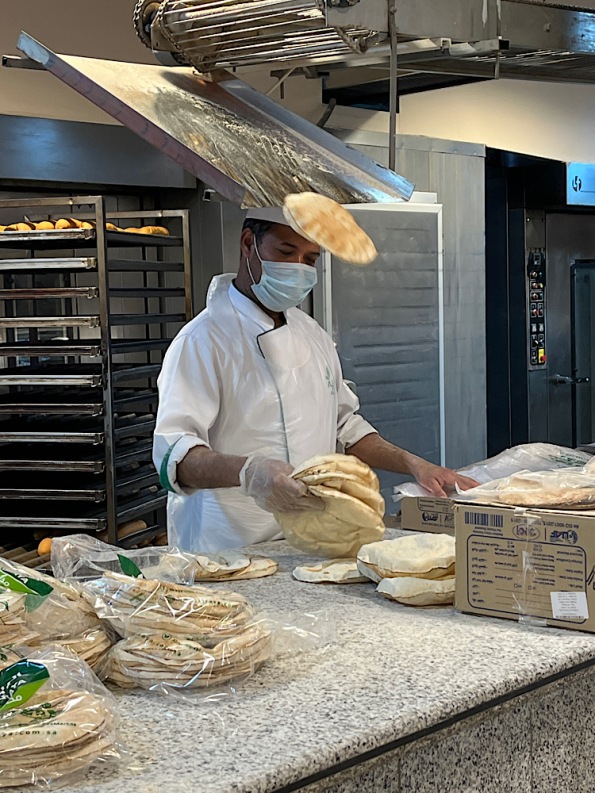
Loaves get put in plastic bags, while new loaves shoot down
It’s a good thing we love bread and aren’t on a low-carb diet. Ever since our trip through Arabia began in November there has been bread on the table for virtually every meal.
I’m not talking about a little bit of bread, but loads and loads of bread. You don’t even have to order it in a restaurant. Whatever you choose automatically comes with bread. If there are four people at the table, you’ll get four loaves of flat, round pocket bread. After you’ve eaten two, four more loaves usually arrive.
Luckily, leftover bread isn’t wasted. At one truck stop we saw a huge tarpaulin covered in leftover loaves being dried for animal feed.
We’ve lived or travelled in about 15 Middle Eastern countries, and bread has been revered in all of those places. But my first introduction to this obsession was in Cairo where bread is called ‘aish’ in colloquial Egyptian Arabic, which literally means ‘life’. In the rest of the Arab world, bread is known as ‘khubz’.
I thought you might like to see some of the different breads we have enjoyed. My favourite pics are a series from a supermarket bakery in Medina, Saudi Arabia. I’ve shared three pics here (and took many more).
Out of the corner of my eye, I noticed bread falling from the ceiling. Hang on, then I realised the warm, just-baked loaves were dropping from an overhead conveyor belt. A fellow was catching them and packing them into bags of 6 loaves. Many customers waited to be handed a bag of fresh, warm bread. I could have stood there all day watching the process, and was glad the fellow said it was okay to take pictures. I even went back a second time and caught a pic of two loaves falling together.
.P.S. I’ve written about bread quite often before. Here’s a piece about roti in India and one about Russian black bread on my cooking blog.
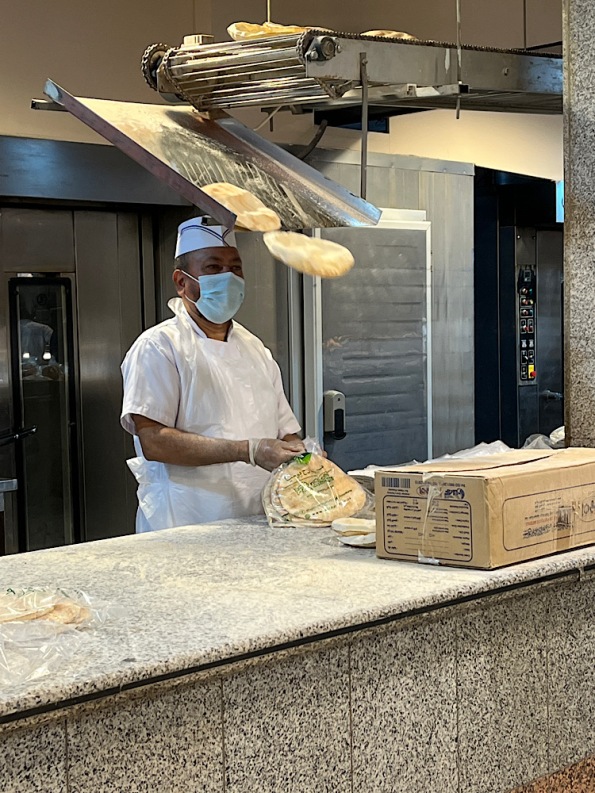
Every now and then two loaves fall together. Notice his smiling eyes
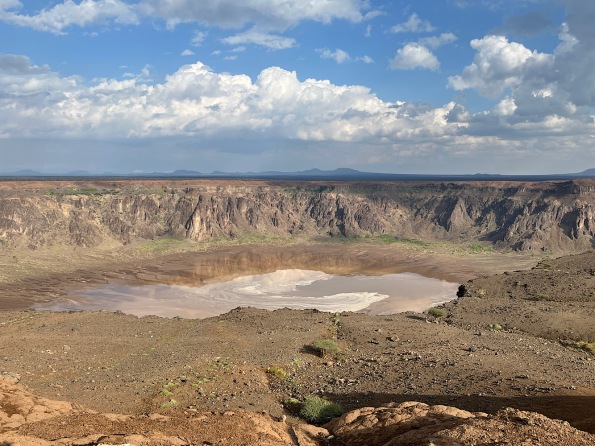
Wahba Crater in sun
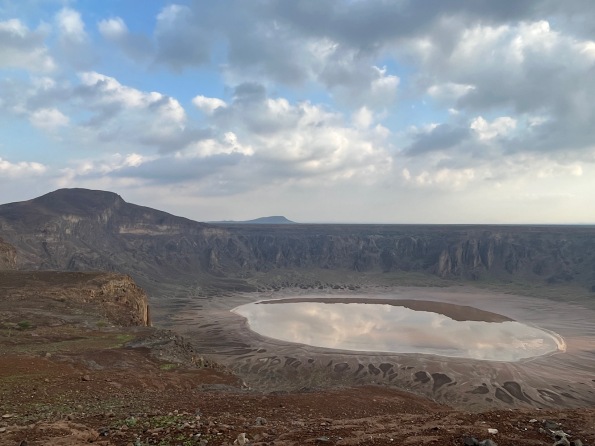
Wahba Crater in shade
We’ve visited some unexpected sites on the Arabian Peninsula, so a volcanic crater was no surprise. Well, maybe a bit of a surprise.
Wahba Crater (also known as Wahbah Crater and Maqlaʿ Ṭamiyyah) is one of many volcanic cones on the Harrat Kishb basalt plateau in the Hejazi region of Saudi Arabia. It’s also the largest and deepest.
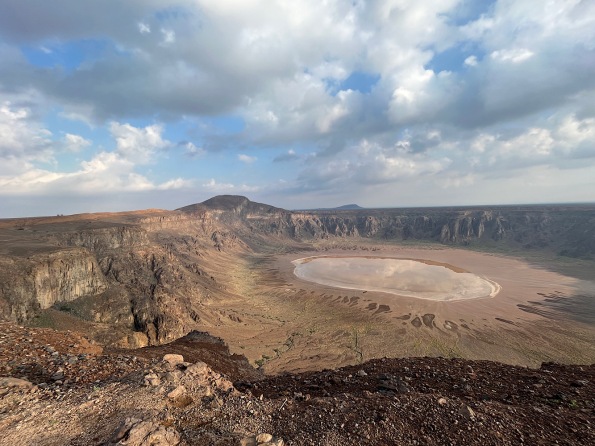
How wide and how deep is it?
One website says it is 380 metres deep and 3000 metres across. Another says it is 250 metres deep and 2000 metres across. Who to believe?
We didn’t climb down to measure the depth, but some of the group walked all the way around the rim—it took them two and a half hours. It rained heavily shortly before we arrived, and the hikers said some of the rim path was muddy and slippery.
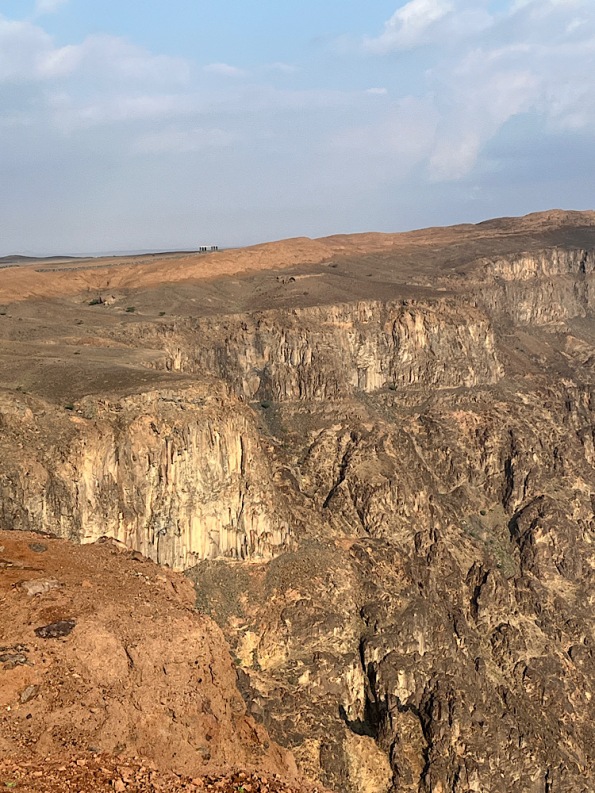
Steep walls of Wahba crater. Abseilers and rock climbers would love it
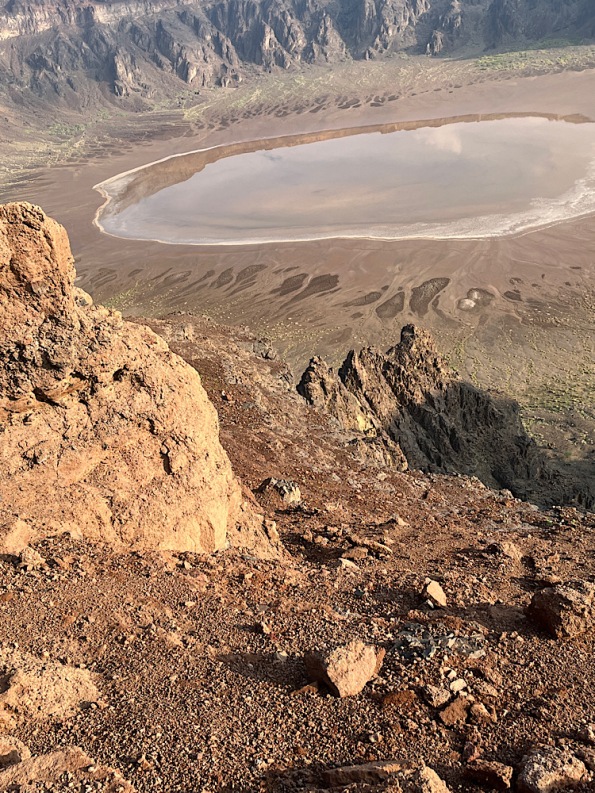
You wouldn’t want to slip over the edge
In fact the sides of the crater are rocky, steep and slippery, which is why it is forbidden to climb down into it. We saw two fellows venture down the only slightly easy path. Within minutes of reaching the bottom, the police appeared and ordered them out. We wondered if there were cameras keeping an eye on things.

Great scenery
The bottom isn’t that inviting anyway. Apparently it is covered with white sodium phosphate crystals. Not good for swimming.
Scientists originally thought the crater was formed by a meteorite, but have since decided it was caused by volcanic activity in the form of a massive underground steam explosion. Of course, there is a legend that the crater was the work of a jealous lover.
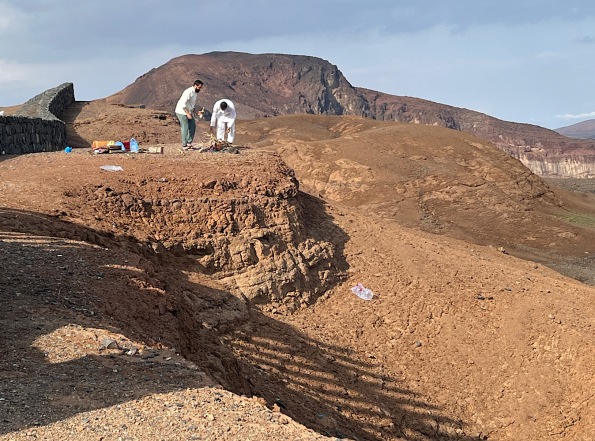
They were getting ready to barbecue some camel, and invited us to join them
There were quite a few tourists who visited while we were there, and a few who stayed to camp. We camped too. The ground was rock hard, and it was almost impossible to pound in the tent pegs. Nevertheless, we were treated to some wonderful skies and fabulous views. The sun and clouds came and went.
P.S. We head into the desert tomorrow and expect to be offline for at least four days.
Happy New Year everyone. May the coming year be kind to you.

Last flash of daylight
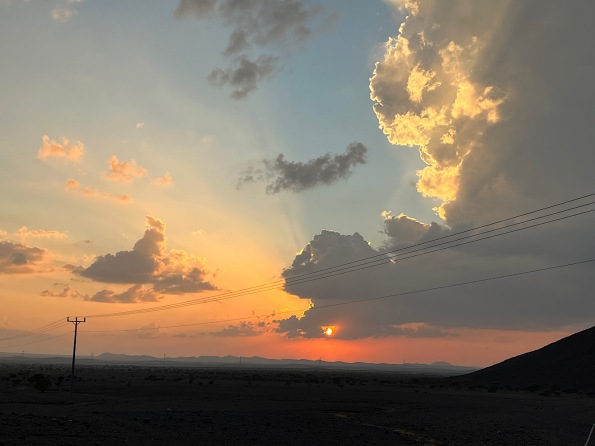
Sunset with power lines at Wahba Crater
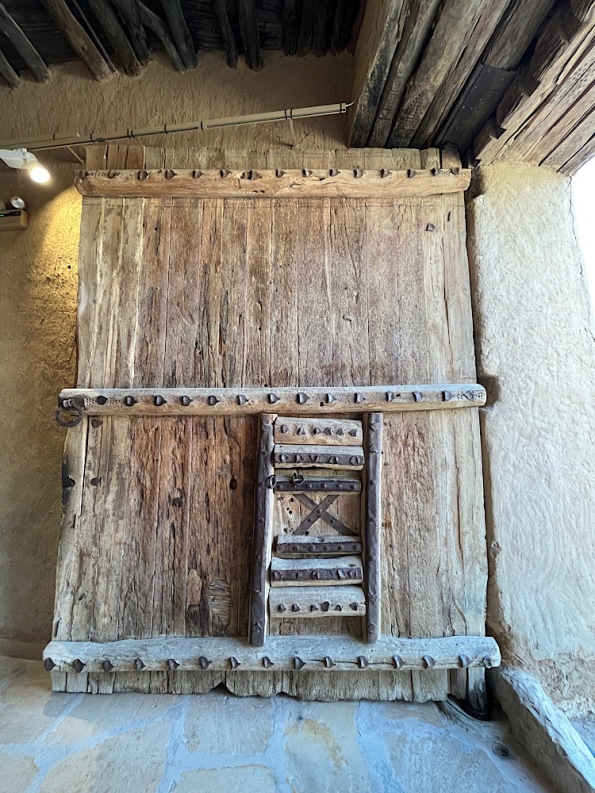
Main door with al-khokha
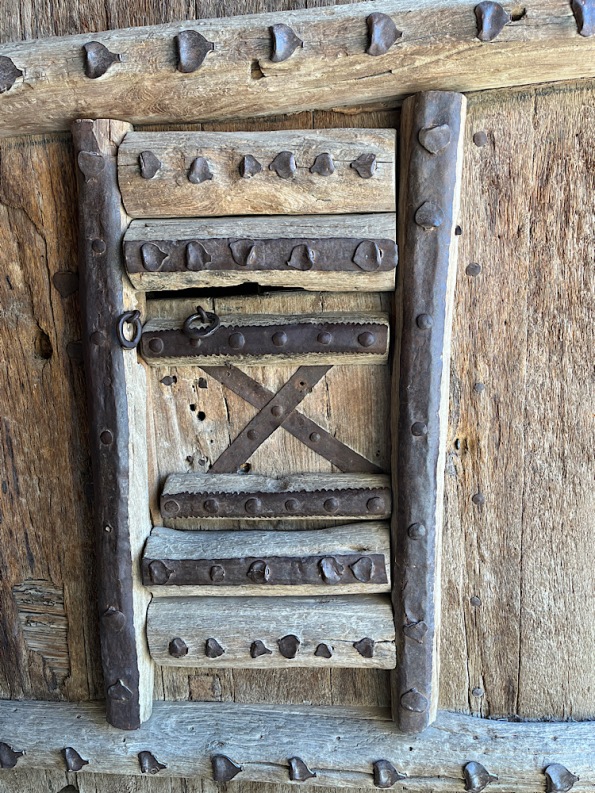
Imagine the spear tip just near the bottom and to the right of the X
Last week, we spent hours roaming through the Masmak Fort, a clay and mud brick structure in the heart of Riyadh.
Built in 1865 for prince ‘Abdurrahman ibn Sulaiman AlDabaan, the fort played an integral role in the nation’s history. The Battle of Riyadh, one of the most important conflicts leading to the reunification of Saudi Arabia, took place in the fort in 1902.
Since 1995 it has been a museum, covering the battle and many other aspects of Saudi history.
You are most welcome to look up details of the battle (way too much information to report here), but I want to share the doors. I have never seen so many different doors in one building.
The first pic shows the gate at the entrance. The rectangular opening in the lower part of the main door is called an al-khokha. It is just big enough for one person to pass at a time, and is a defensive feature designed to allow people in and out without opening the door. The second pic is a close-up of the al-khokha. The guide showed us the tip of a spear stuck in the door just to the right of the al-khokha. It’s a remnant of the battle in 1902, but impossible to photograph. Pretend you can see it.
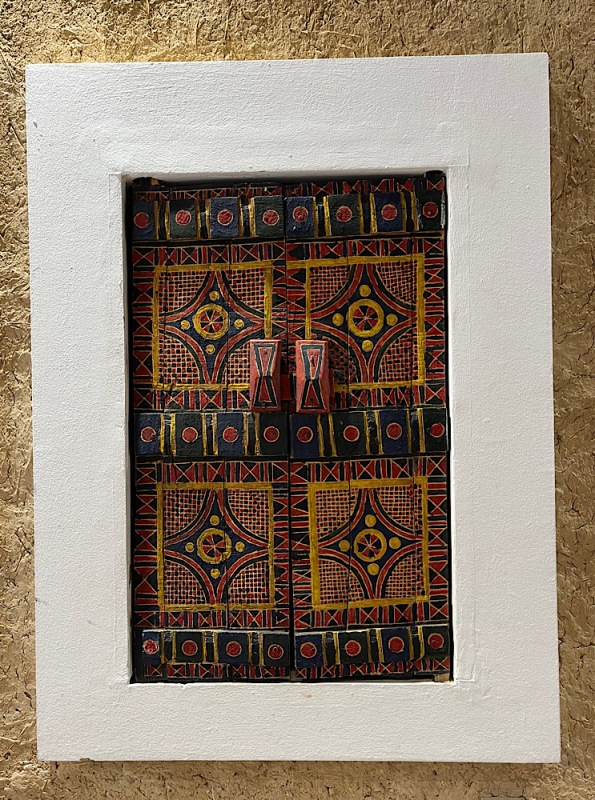
Window shutters
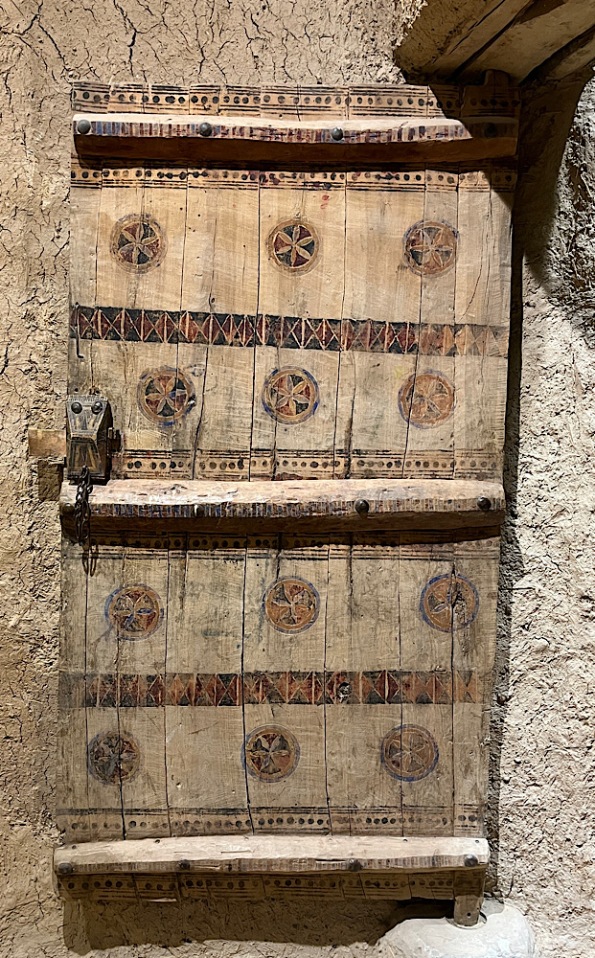
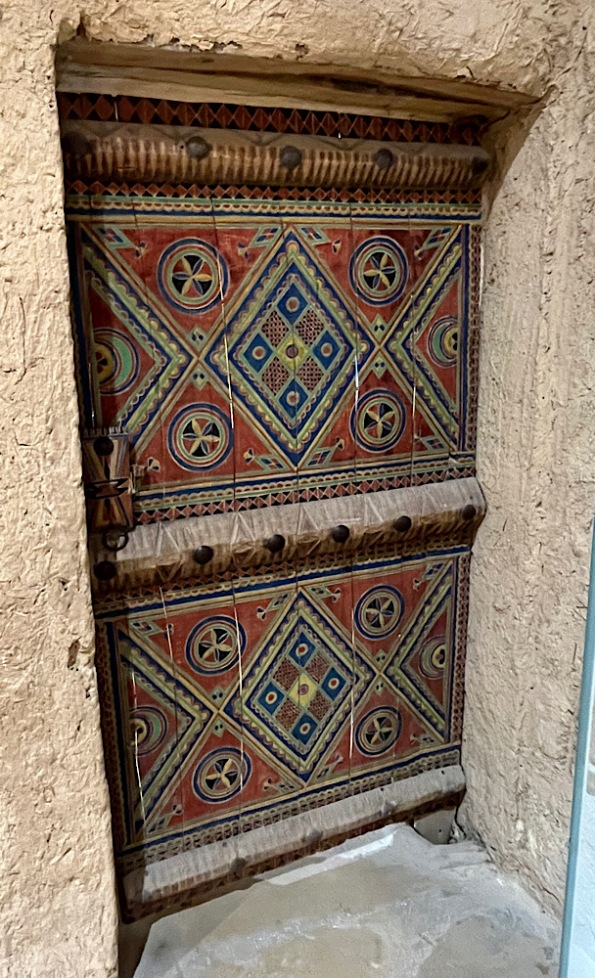
Some doors are plain, some are colourful, many are faded. Here’s a selection including one set of window shutters. There are very few captions.

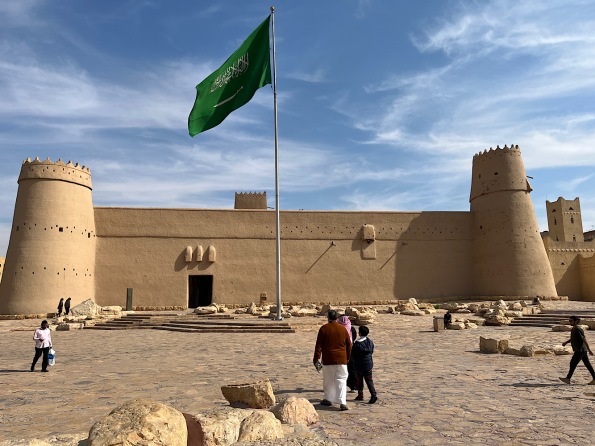
Masmak Fort
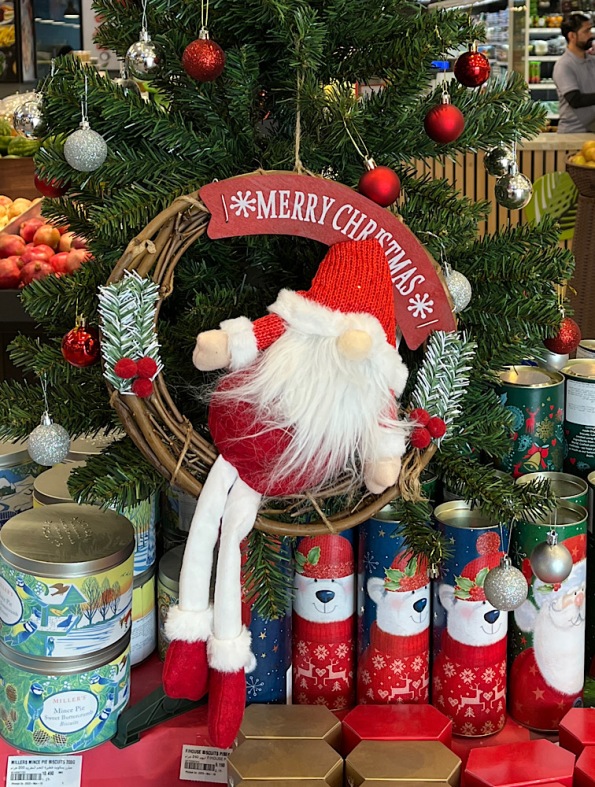
Islam is the predominant religion in Arabia, but that doesn’t mean there aren’t plenty of signs of Christmas. Here are a few we have seen since our travels began in November in the United Arab Emirates. The pics have been taken in department stores, hotels, restaurants and supermarkets.
Today we had an amazing fish lunch on Saudi Arabia’s Farasan Island, and the restauranteur wished us Merry Christmas. More soon about that divine meal and the restaurant itself.
Now I want to wish all of you a very Merry Christmas, Happy Holidays and Season’s Greetings.
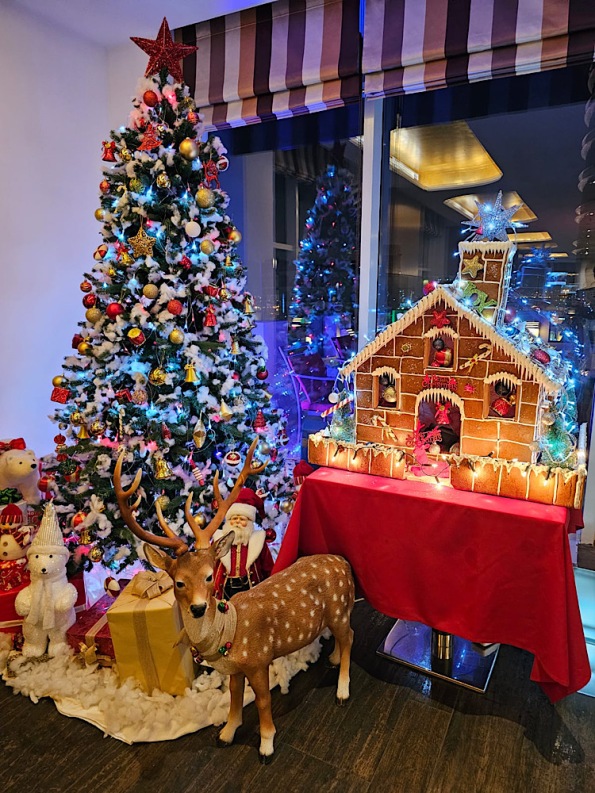
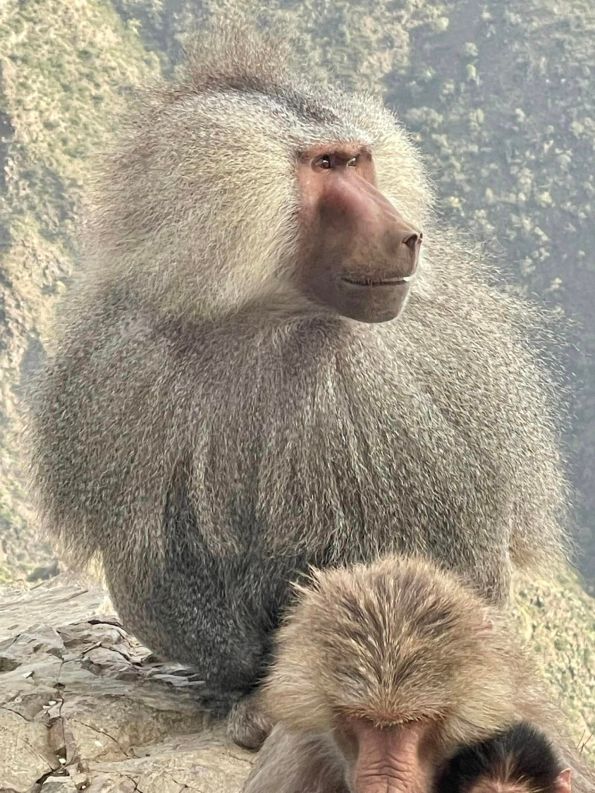
Photo by Alison Cole
Over the last few days we’ve been surprised to see what we first thought were troops of monkeys along the roadside in southwestern Saudi Arabia.
Turns out they are hamadryas baboons, a species of baboon within the Old World monkey family.
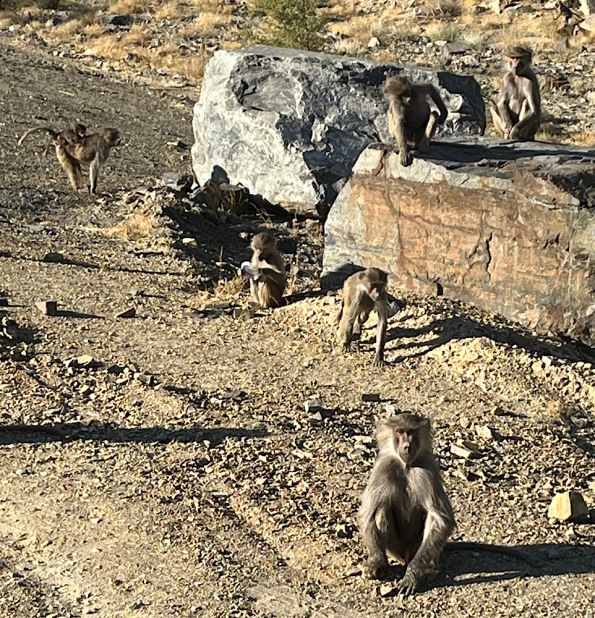
Ancient Egyptians believed they were a sacred animal and included them in various religious activities. Today they are extinct in Egypt. These baboons are now native to the Horn of Africa and the Sarawat Mountains in the southwestern part of the Arabian Peninsula, which is where we are seeing them.
I’m a little wary around baboons in general. They can be quite a nuisance in Africa. They’ll break into and ransack a tent if they get so much as a whiff of something as trivial as toothpaste. I have seen them in action in several African campgrounds and tourist locations.
We have been able to enjoy these hamadryas baboons mostly at a distance, although some of my travelling companions have ventured much closer. I also noticed that a few folks were quick to back away.
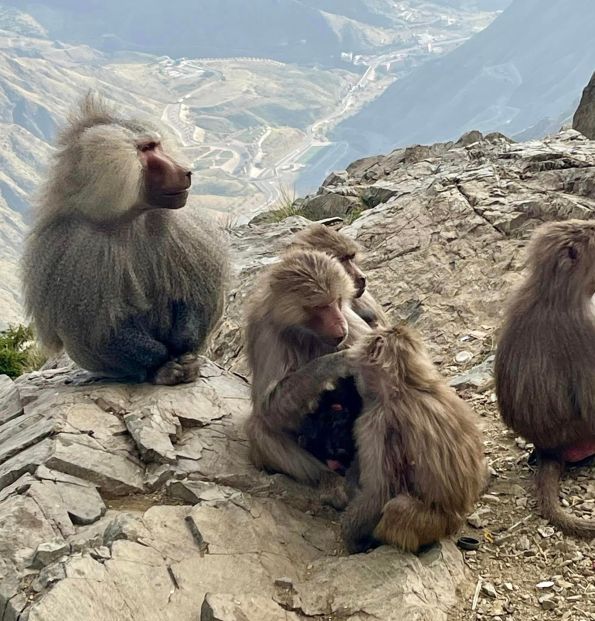
Photo by Alison Cole
I saw a Saudi family picnicking at one location. As soon as the baboons approached, they packed up the food and blankets, hopped in the car and drove away. They know baboons.
Many thanks to my fellow passengers for the use of their pics. I have contributed only one. No captions except to identify the photographer.
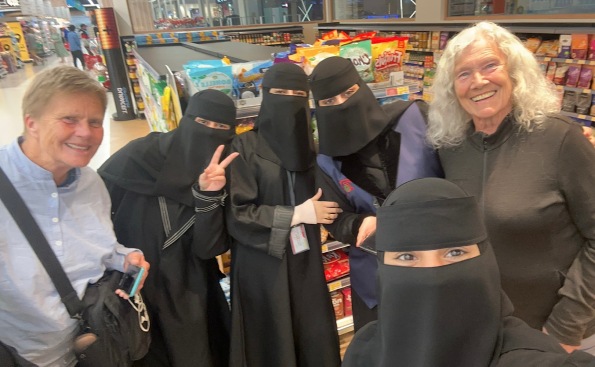
Chris and me with new friends in the supermarket
Chris and I had a wonderful encounter with five local women in a supermarket in Hafar Al-Batin in northeastern Saudi Arabia.
It started with my quest for a bag of boiled lollies, preferably mint-flavoured. They’re a treat on the bus, great for a dry throat and a good thing to share. But everything in the supermarket seemed to be chewy and toffee-like or chocolate.
So I used my out-of-date Arabic to ask the woman at the nut counter for some help. It all unfolded from there. Eventually, she called in fellow saleswomen to help in the search.
They were convinced I needed a sugar-free-for-diabetics version, but I kept saying sugar was okay.
My rusty Arabic got a good work and so did their English. We shared laughs, photos and conversations.
Chris said the one thing she didn’t like about them being covered was that she couldn’t see their beautiful faces. So one of them shared a Snapchat pic of herself with long blonde hair and a pink gown. Wow, what a knockout!
As for the lollies, there weren’t any to be found. Who cares. What a memorable experience.
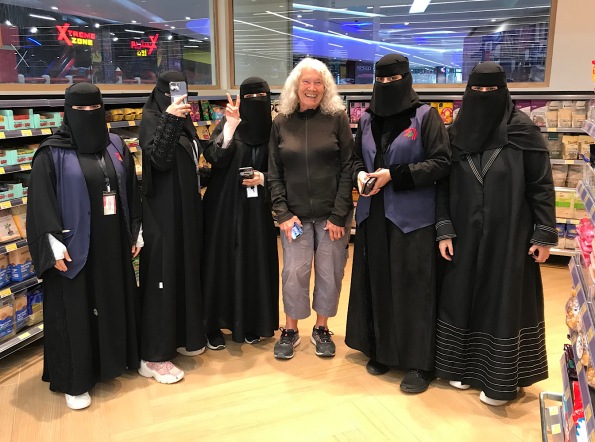
Six of us couldn’t find boiled lollies. Photo by Chris
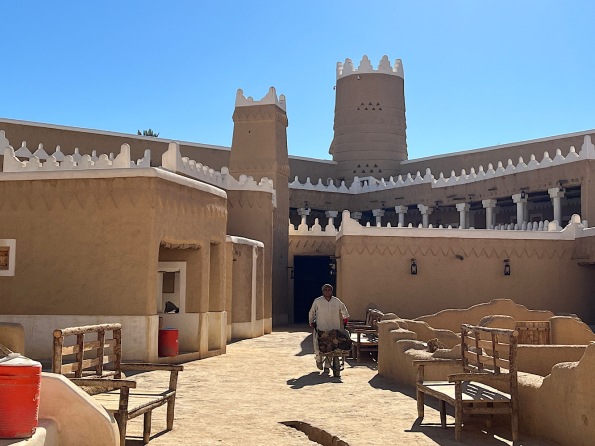
Al Jeraisy Castle is getting a facelift
Today we travelled from Ushayqir to Riyadh in Saudi Arabia, with a brief stop at Al Jeraisy Castle. We knew it was closed for maintenance, but thought it was worth having a look at the outside.
I’ve been unable to find out much about this castle. The museum next to it was closed. I found a 264-page academic paper online that gives it a rather clinical paragraph.
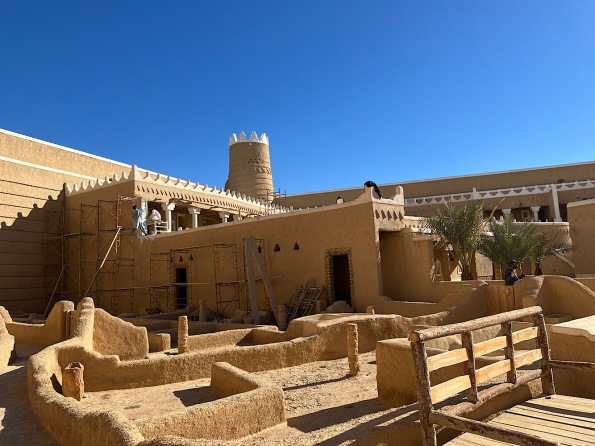
A lot of paintwork is being done
It says, more or less, that it was built by Ali Al Jeraisy, the Prince of Raghbah. The total area of the castle is 5116 square metres. The four walls measure in length from 49 to 68 metres. They are 3 metres thick at the base and gradually narrow to 1 metre at the top. There’s a 16.5-metre tower in every corner, with ‘observation holes for monitoring enemy movements.’

Vit peers in through the cracks. The hatch with the X opened
But here’s the surprise. We walked around to the front of the castle where there is a gate. We dutifully took pics, but Vit approached and peered through the cracks. He said he could see people inside, and suddenly a hatch opened.
The foreman invited us to look in through the hatch and take a quick pic. We started taking turns and when I popped my head in, I saw him on the phone and heard him asking permission to let us in through the gate.
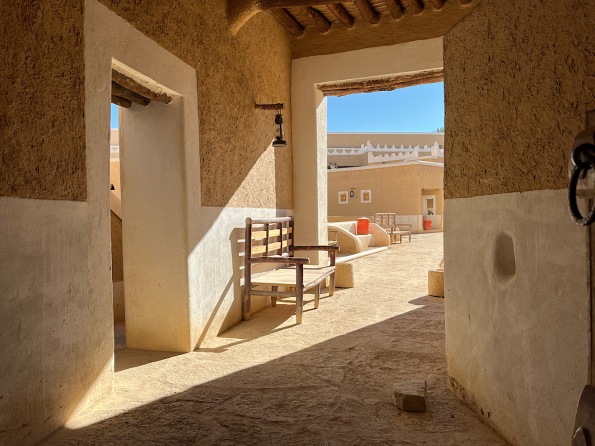
What we could see through the hatch at Al Jeraisy Castle
He obviously got the okay, because part of the gate soon opened. We were allowed to step in about 5 metres and see the amazing restoration work being carried out.
This will be a real showpiece when it’s completed, but we feel especially lucky to see the work in progress.
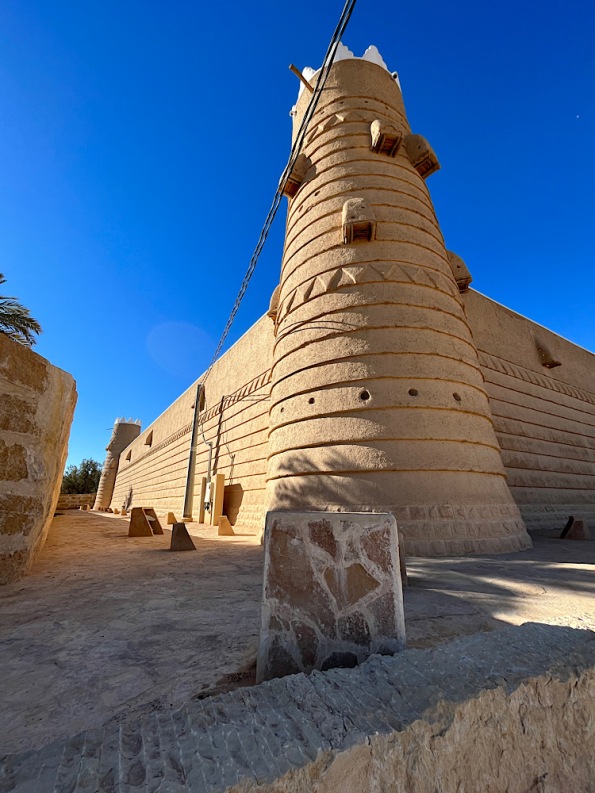
Our first look at the towers of Al Jeraisy Castle
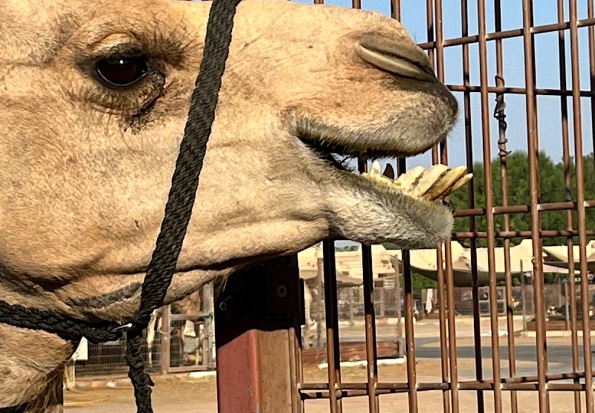
Plenty of countries have huge numbers of camels—Somalia is estimated to have 7 million—but Australia has the largest population of genuinely wild camels.
With more than 1 million feral camels, you’d think we see them peering over the back fence, but they are mostly scattered across our central desert. I’ve seen them only in the outback.
But domestic and wild camels can be seen all over the Arabian Peninsula. We got our first close-up look at these beasts in the Al Ain Livestock Market, east of Abu Dhabi in the United Arab Emirates.
In addition to camels, the market features goats, cows and sheep. Apparently the animals and their sellers hang around until all sales are completed. The animals come in all colours, sizes and ages.
The sellers come from long distances, even as far away as Sudan and Afghanistan.
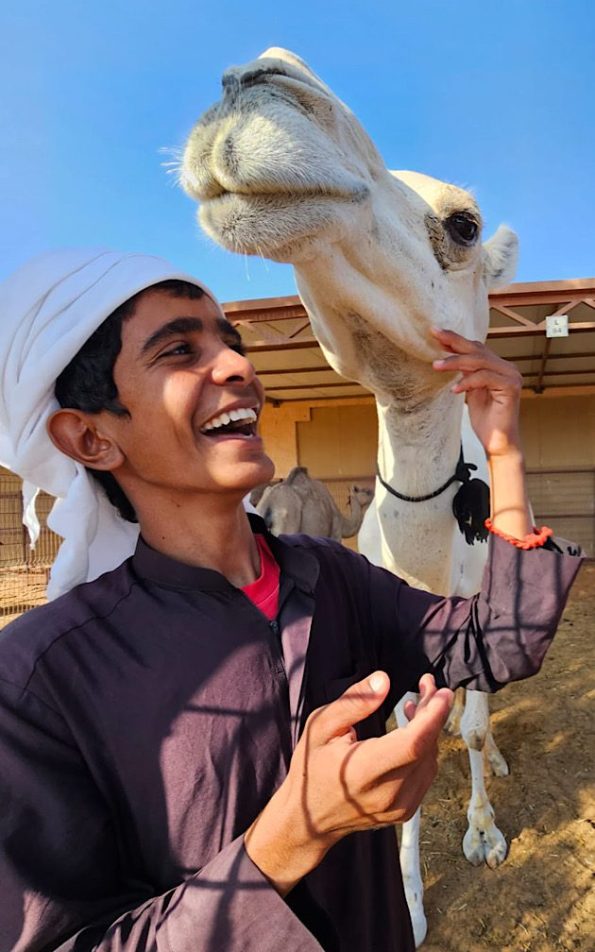
Young man with camel. Photo by Annette Gribbin
Some camels are bought for racing or breeding purposes, but I think most end up as meat. Not sure about the fate of goats, sheep and cows.
We saw animals (mostly camels) being loaded into trucks and the back of pickups. It’s quite a sight to see a camel trussed up and hoisted into a truck. It’s all snarls, struggle and snorting even after liftoff. I felt so sorry for them.
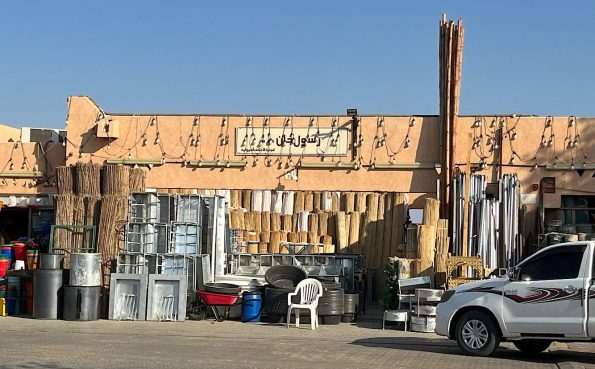
Farm goods for sale
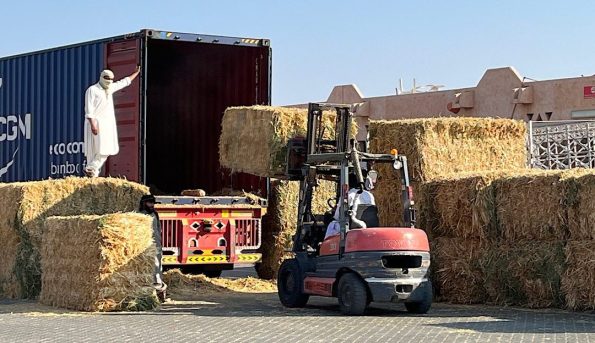
Unloading hay
There were also sales of feed, farm wares, and some household goods.
We’re visiting another camel market soon in Saudi Arabia. I wonder how much different it will be?
Note: Not all pics have captions. Also, the video at the bottom of the post is of a camel being loaded unto a truck (turn up the sound). If you can’t view it, the four still photos just above the video show the same process.
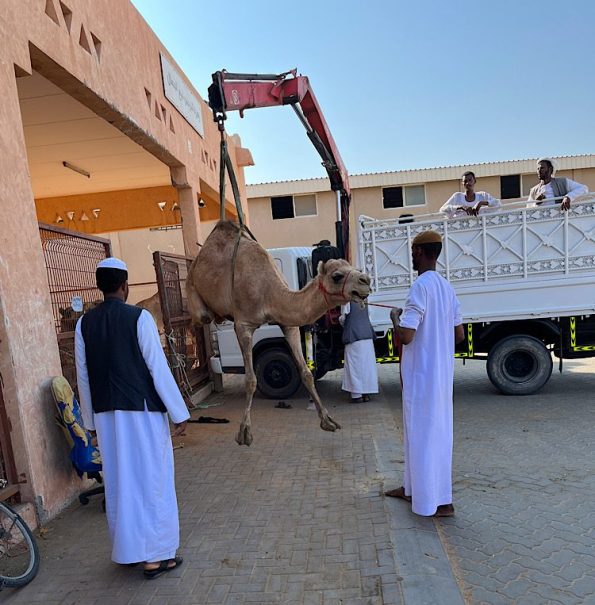
Loading a camel 1
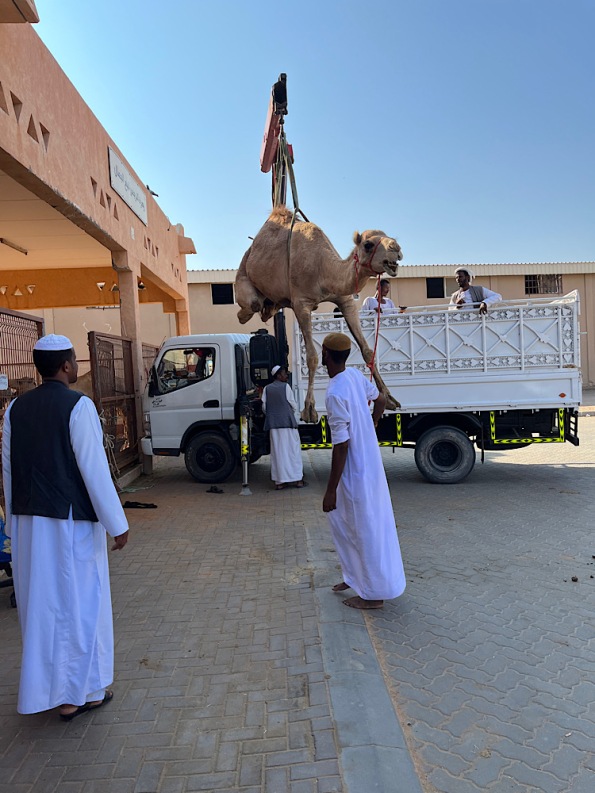
Loading a camel 2
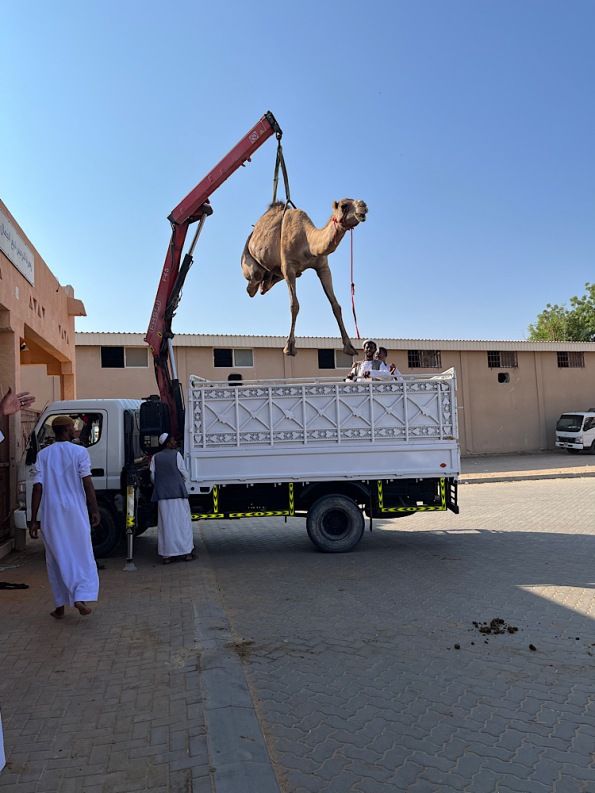
Loading a camel 3
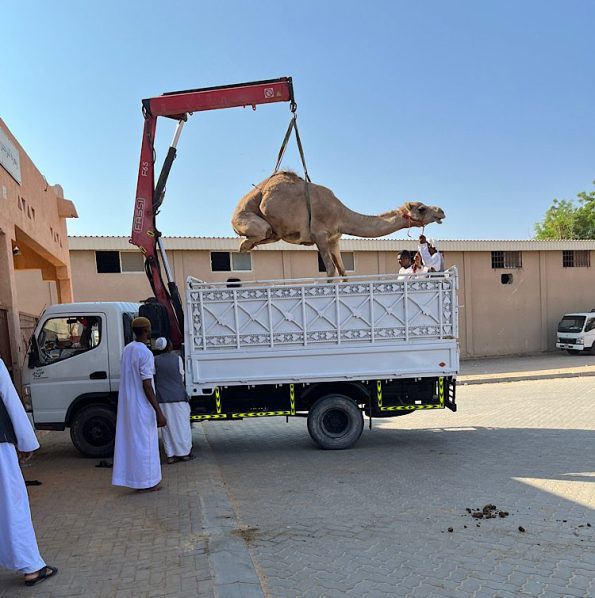
Loading a camel 4
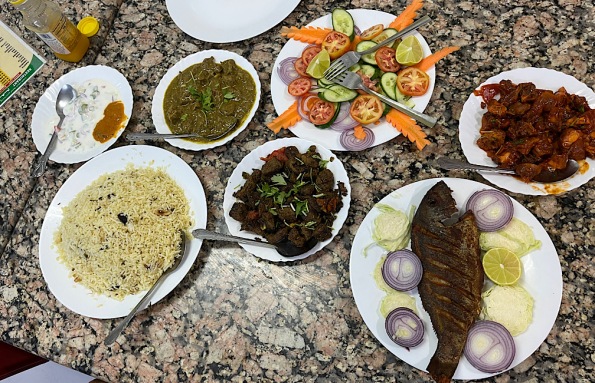
Our magnificent dinner in Oman
Arabia is a melting pot of cuisines. Of course, foods from the peninsula—United Arab Emirates, Bahrain, Kuwait, Oman, Qatar, Saudi Arabia and Yemen— are represented, as well as foods popular with the many workers who have flocked to jobs there.
We’ve seen restaurants specialising in dishes from Bangladesh, India, Ireland, Korea, Mexico, Pakistan, Philippines, Thailand and more.
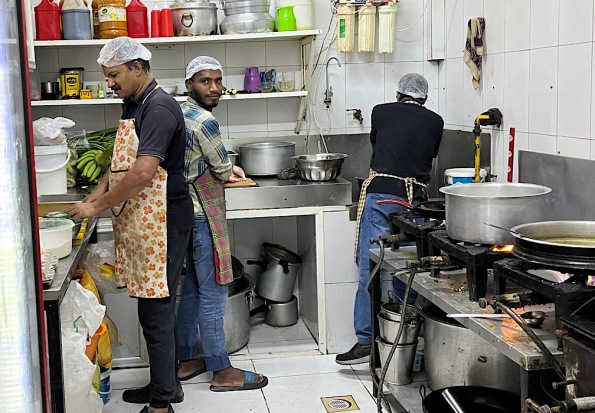
But one night’s meal stands out as particularly special for many reasons. We stayed two nights at the Salalah Garden Hotel in the south of Oman. This huge hotel covers more than a city block and is located over an equally large shopping mall complete with countless restaurants and a food court.
But that’s not where we ate. The first day, Poor John and I walked all the way around the hotel. About halfway, we noticed a small restaurant next to a petrol station.
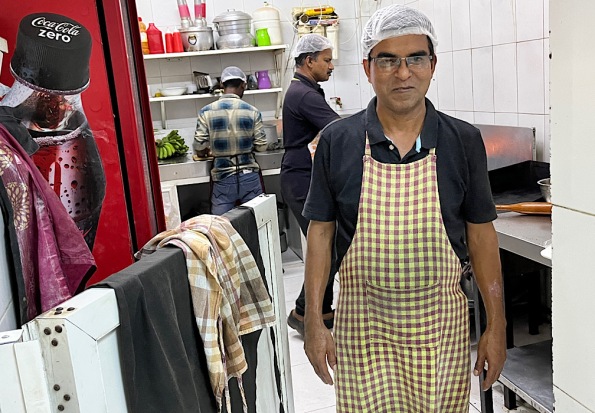
The head chef
This was a magnet to Poor John, but I said I’d really rather not eat in the ‘driveway’ of a service station if I didn’t have to. Of course, the next night that’s exactly where four of us ended up. New Zealand sisters, Rose and Susan joined us.
We were quite surprised to see how busy it was, with customers at tables and plenty of people popping in to pick up takeaway.orders.
There was a menu posted on the wall and a handwritten sign listing the specials.
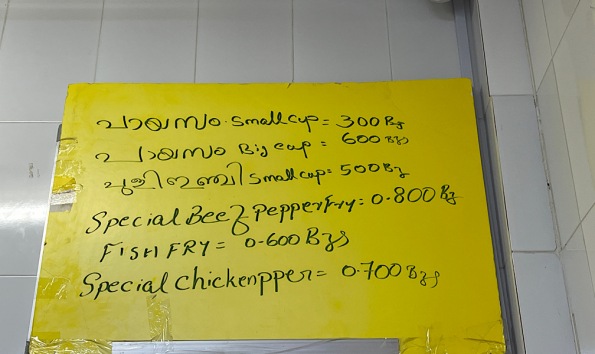
Specials menu
We ordered the three specials—beef pepper, chicken pepper and the fish fry, which the waiter (owner?) was keen for us to try. Also ordered rice, salad and another chicken dish. As an aside, an Omani rial is worth about A$4.
We chatted with some of the customers and I was allowed to take pictures of the kitchen and staff. But the big surprise came when the food arrived and a customer said that he was paying for our meals. He said, more or less, that we were guests in his country and it was the least he could do.
But we were in for another surprise. The food was superb, especially the fish fry. I could eat that every day. Done to perfection.
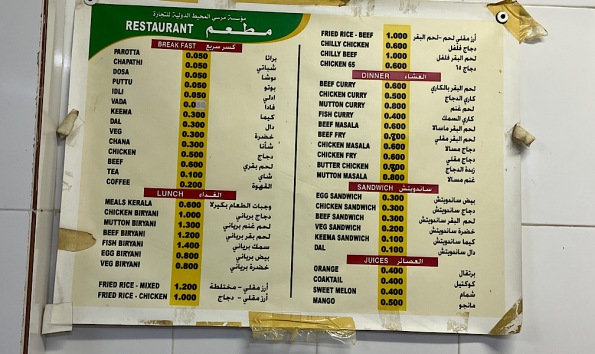
As we left, I asked the waiter (owner?) if the man who paid for our dinner was likely to come in again. It seems he eats there regularly, so we asked the waiter to once again pass on our thanks for his generosity.
Notes; If Google maps is right, the restaurant is called Saleemkka’s. Also, this 54-day adventure includes 22 nights of camping. That’s when the group takes turns cooking dinner and breakfast. We have eaten very well.

Saleemkka’s Restaurant in Oman. The petrol station is to the left
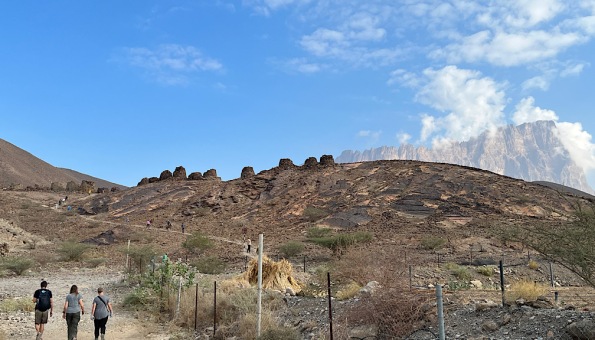
Appraching the tombs with Jabal al Misht in background
Cemeteries always make for an interesting stop on an overland trip, but the beehive tombs in Oman set a whole new benchmark for fascinating.
Together the three archaeological sites of Bat, Al-Khutm and Al-Ayn form the world’s most complete and best preserved collection of settlements and cemeteries (also called necropolises) from the 3rd millennium BCE.
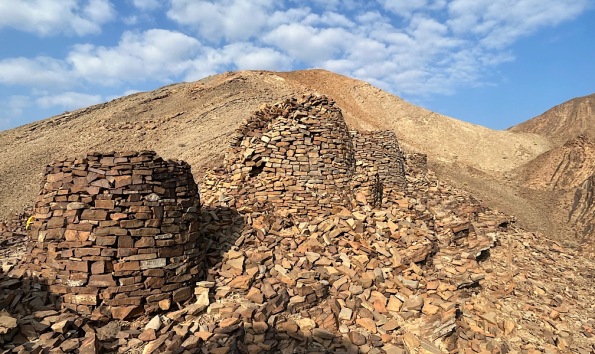
They are so important that UNESCO designated them as a World Heritage Site in 1988.
We were lucky enough to visit the tombs at Al-Ayn. While it is the smallest of the three necropolises, it is the most accessible and most scenic, and in the best condition.
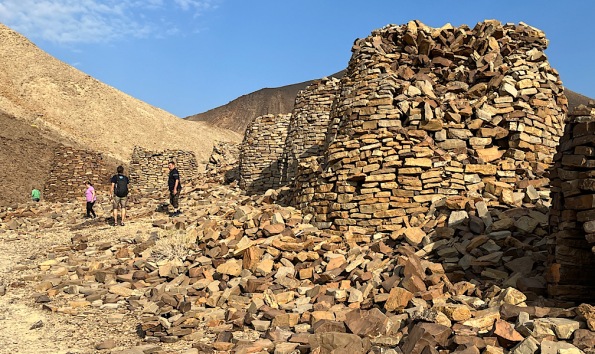
Plenty of stuff as building materials
That, in itself, is remarkable. Since being designated world heritage, the sites have not been restored or had any other type of conservation. Their isolation has been their only protection. One of the greatest dangers comes from locals who take pieces to use as building material.
Al-Ayn has 21 ‘beehives’ with 19 still standing. These structures are strung out on a hill near Jabal al Misht (Comb Mountain).
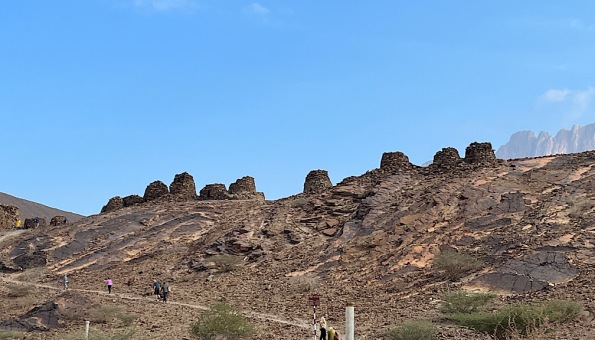
String of tombs at Al Ayn, Jamal al Misht in the background

Jabal al Misht in the distance
I say structures because it is assumed they are tombs. No remains of animals or humans have ever been found in any of the ‘tombs’.
I’ve found websites that say you can enter some of the monuments, but I never noticed any openings. However the surrounding landscapes are breathtaking.
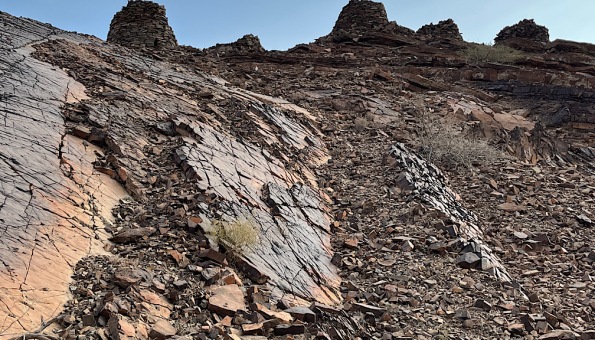
Looking up at tombs
We could see the row of beehives from quite a distance and the walk up to them wasn’t too steep. On the way, we crossed what is probably a dry river bed. Note to self: don’t visit in the rainy season.
Once there we scrambled around the uneven rocks and enjoyed the views. Highly recommended and free!

Looking out over the countryside























